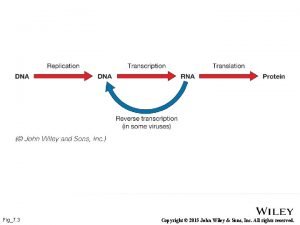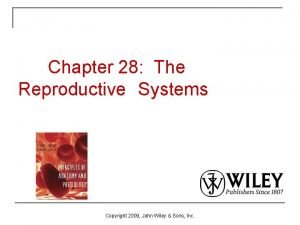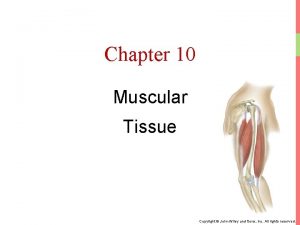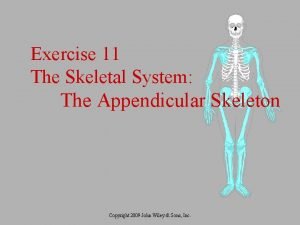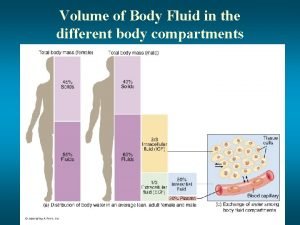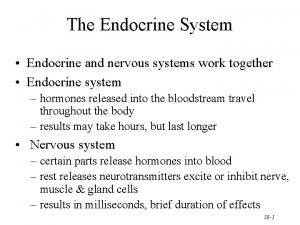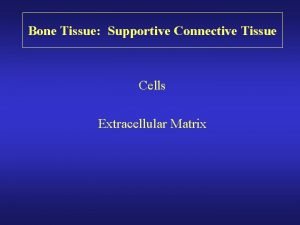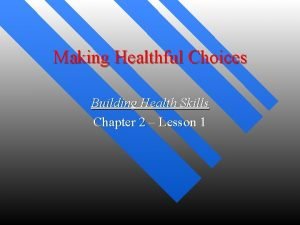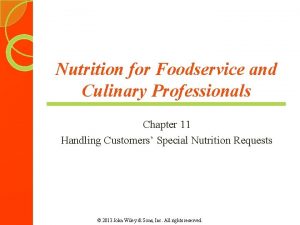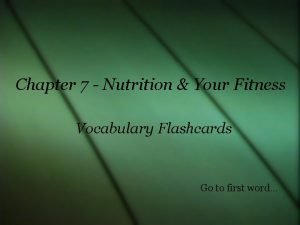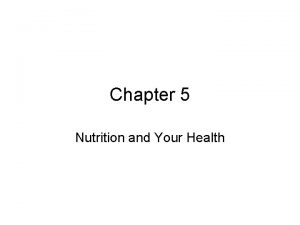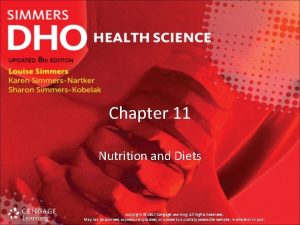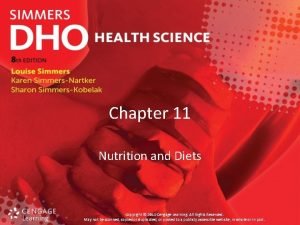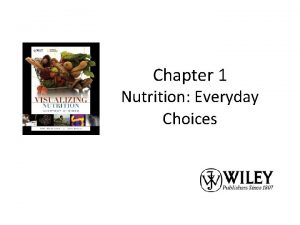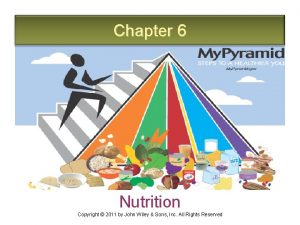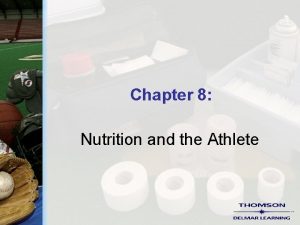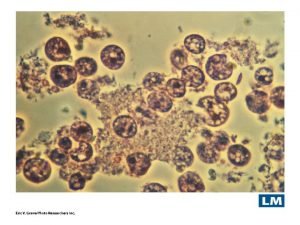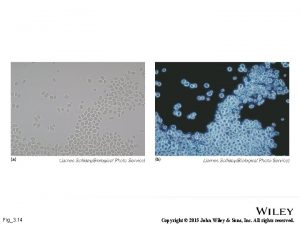Chapter 1 Nutrition Everyday Choices 2015 John Wiley












































- Slides: 44

Chapter 1 Nutrition: Everyday Choices © 2015 John Wiley & Sons, Inc. All rights reserved.

Introduction ■ Food choices – Most people around the world make food choices based on what they can grow, raise, catch, kill, or purchase – Subsistence is the principal motivator of food consumption – Due to the modern agriculture and food production, Americans make choices based on what they like or on how the food will affect their health © 2015 John Wiley & Sons, Inc. All rights reserved.

FOOD CHOICES AND NUTRIENT INTAKE © 2015 John Wiley & Sons, Inc. All rights reserved.

Nutrients from Foods ■ Nutrients—a substance in food that provides energy and structure to the body and regulates body processes ■ Any food you eat adds some nutrients to your diet, but to make your diet healthy, it is important to choose nutrientdense foods – Nutrient density—a measure of the nutrients provided by a food relative to its calorie content © 2015 John Wiley & Sons, Inc. All rights reserved.

© 2015 John Wiley & Sons, Inc. All rights reserved.

© 2015 John Wiley & Sons, Inc. All rights reserved.

Nutrients from Fortified Foods ■ In addition to nutrients that occur naturally in foods, we obtain nutrients from fortified foods – Fortification—the addition of nutrients to foods ■ The fortification of foods was begun to help eliminate nutrient deficiencies in the population, with the federal government mandating that certain nutrients be added to certain foods – Vitamin D added to milk – B vitamins added to grains – Various vitamins added to breakfast cereals © 2015 John Wiley & Sons, Inc. All rights reserved.

Nutrients from Dietary Supplements ■ Dietary supplement—a product sold to supplement the diet; may include vitamins, minerals, amino acids, fatty acids, enzymes, herbs, or other substances ■ Half of U. S. adults take supplements daily – Do you take dietary supplements? ■ Supplements provide nutrients but do not offer all of the benefits of whole foods © 2015 John Wiley & Sons, Inc. All rights reserved.

Foods ■ Products derived from plants or animals that can be taken into the body to yield energy and nutrients for the maintenance of life and the growth and repair of tissues © 2015 John Wiley & Sons, Inc. All rights reserved.

Foods Provide More Than Nutrients ■ Foods contain substances that can be beneficial for health ■ In plants, these health-promoting substances are called phytochemicals – Phytochemicals—a substance found in plant foods that is not an essential nutrient but may have healthpromoting properties – Zoochemicals—substances from animal foods with health-promoting properties © 2015 John Wiley & Sons, Inc. All rights reserved.

© 2015 John Wiley & Sons, Inc. All rights reserved.

Functional Foods ■ Foods that contain physiologically active compounds that provide health and benefits beyond their nutrient contributions (designer foods, nutraceuticals) – Examples—cholesterol-free eggs, lactose-free milk, calcium-fortified juice, yogurt (good bacteria added) © 2015 John Wiley & Sons, Inc. All rights reserved.

© 2015 John Wiley & Sons, Inc. All rights reserved.

What Determines Food Choices? ■ ■ ■ ■ Rewards/punishments Commemorate milestones Comfort/security Availability/in season Culture/tradition Social interactions Environment Health – Allergies – Weight – Chronic disease (treatment/prevention) © 2015 John Wiley & Sons, Inc. All rights reserved.

NUTRIENTS & THEIR FUNCTIONS © 2015 John Wiley & Sons, Inc. All rights reserved.

The Nutrients ■ Carbohydrates ■ Protein ■ Lipids (Fats) ■ Water ■ Vitamins ■ Minerals © 2015 John Wiley & Sons, Inc. All rights reserved.

Essential Nutrients ■ Needed from outside of the body (from food) because the body either cannot make them or cannot make them in sufficient amounts ■ All six classes of nutrients are essential © 2015 John Wiley & Sons, Inc. All rights reserved.

Nutrient Functions ■ Energy—the fuel our cells use to do work ■ Structure—muscles, bones, water, tendons, etc. ■ Regulation—body temp, blood pressure, hormones, etc. © 2015 John Wiley & Sons, Inc. All rights reserved.

The Macro- and Micronutrients ■ Macronutrients—needed in large quantities – Carbohydrates – Protein – Lipids (fats) – Water ■ Micronutrients—needed in smaller quantities – Vitamins – Minerals © 2015 John Wiley & Sons, Inc. All rights reserved.

Chemical Composition of Nutrients ■ Inorganic nutrients – Minerals ■ ■ ■ Fe (Iron) Na (Sodium) Ca (Calcium) K (Potassium) Cl (Chlorine) – Water (H 2 O) – Inorganic nutrients do not contain carbon ■ Organic nutrients – Vitamins – Carbohydrates – Protein – Lipids – These all contain carbon as part of their structure – Organic = “alive”, carbon-containing © 2015 John Wiley & Sons, Inc. All rights reserved.

Nutrients Carbohydrates Lipids Proteins Vitamins Minerals Sugars Saturated Found in most food groups B 12 Iron Starches Monounsaturated Numerous proteins play various roles in the body Vitamin C Magnesium Fiber Omega-3 and 6 Niacin Calcium Cholesterol Vitamin D Zinc © 2015 John Wiley & Sons, Inc. All rights reserved. Water

Calories ■ A calorie is a unit of measure of the amount of energy in a food ■ Calories are not a substance present in food – They are not like vitamins or minerals or fat ■ Because calories are a unit of measure, they do not qualify as a nutrient ■ Calorie = kilocalorie = 1000 calories © 2015 John Wiley & Sons, Inc. All rights reserved.

The Energy-Yielding Nutrients ■ The energy-yielding nutrients are those that provide Calories to the body – Carbohydrates (provide 4 Calories per gram) – Lipids (provide 9 Calories per gram) – Proteins (provide 4 Calories per gram) © 2015 John Wiley & Sons, Inc. All rights reserved.

NUTRITION IN HEALTH & DISEASE © 2015 John Wiley & Sons, Inc. All rights reserved.

What happens when a person gets too little or not enough of a nutrient or energy? ■ Malnutrition—any condition caused by excess or deficient food energy or nutrient intake or by an imbalance of nutrients ■ A person can be both over- and under-nourished © 2015 John Wiley & Sons, Inc. All rights reserved.

Undernutrition © 2015 John Wiley & Sons, Inc. All rights reserved.

Overnutrition © 2015 John Wiley & Sons, Inc. All rights reserved.

Diet-Gene Interactions ■ Diet affects your health, but diet alone does not determine whether you will develop a particular disease ■ Each of us inherits a unique combination of genes – Units of a larger molecule called DNA that are responsible for inherited traits ■ Some of these genes affect your risk of developing chronic diseases, such as heart disease, cancer, high blood pressure, and diabetes, but their impact is affected by what you eat © 2015 John Wiley & Sons, Inc. All rights reserved.

Nutritional Genomics © 2015 John Wiley & Sons, Inc. All rights reserved.

CHOOSING A HEALTHY DIET © 2015 John Wiley & Sons, Inc. All rights reserved.

Healthy Diet ■ Variety-balance-moderation ■ High in fruits, vegetables, whole grains ■ Moderate in calories, sodium, sugar ■ Low in unhealthy fats (trans fats, saturated fats, cholesterol) © 2015 John Wiley & Sons, Inc. All rights reserved.

Eat a Variety of Foods ■ Choosing a variety of foods is important because no single food can provide all the nutrients the body needs for optimal health ■ Variety—choosing foods from different food groups and choosing different foods within each group © 2015 John Wiley & Sons, Inc. All rights reserved.

Make Sure to Have Balance in Your Diet ■ Balance unhealthy choices with healthy choices ■ Balance calories in with calories burned ■ Balance foods within food groups ■ A balanced diet balances healthy foods with unhealthy ones and balances the amount of Calories with the amount you burn doing daily activities © 2015 John Wiley & Sons, Inc. All rights reserved.

Balance © 2015 John Wiley & Sons, Inc. All rights reserved.

All Things in Moderation ■ Moderate portion sizes ■ Moderate consumption of each food ■ Moderation—not overdoing it; not having too many calories, fat, sugar, salt, alcohol © 2015 John Wiley & Sons, Inc. All rights reserved.

EVALUATING NUTRITION INFORMATION © 2015 John Wiley & Sons, Inc. All rights reserved.

The Science Behind Nutrition ■ The science of nutrition is constantly evolving ■ The scientific method—the systematic, unbiased approach that allows any science to acquire new knowledge & correct & update previous knowledge ■ In nutrition, the scientific method is used to develop nutrient recommendations, understand the functions of nutrients, and learn about the role of nutrition in promoting health & preventing disease © 2015 John Wiley & Sons, Inc. All rights reserved.

Science of Nutrition– Scientific Method ■ Make an observation ■ Propose a hypothesis ■ Design & conduct experiment to test hypothesis ■ Analyze results ■ Publish & present with peer review ■ Repeat and experiments ■ Develop theories based on results from many experiments © 2015 John Wiley & Sons, Inc. All rights reserved.

■ Hypothesis—a proposed explanation for an observation or a scientific problem that can be tested through experimentation ■ Theory—a formal explanation of an observed phenomenon made after a hypothesis has been tested and supported through extensive experimentation © 2015 John Wiley & Sons, Inc. All rights reserved.

The Scientific Method © 2015 John Wiley & Sons, Inc. All rights reserved.

How Scientists Study Nutrition ■ Different types of experiments – Epidemiological studies make observations about relationships between health and diet – Experimental studies ■ Clinical trials explore the health effects of altering people’s diets. ■ Animal studies explore the health effects of altering diets in animals. ■ Biochemistry and molecular biology—laboratory-based techniques that are used to study nutrient functions in the body © 2015 John Wiley & Sons, Inc. All rights reserved.

Epidemiological Studies © 2015 John Wiley & Sons, Inc. All rights reserved.

■ The most important thing is that the data collected is reliable, can be quantified (measurable) – Examples of measurables: body weight, blood pressure, blood cholesterol, etc. – Things that are not measurable: testimonies and opinions © 2015 John Wiley & Sons, Inc. All rights reserved.

Questions To Ask About Nutrition Data ■ Does it seem too good to be true? ■ Who is providing the information? Do they have something to gain? Who performed the study? ■ Are there other studies that support this information? © 2015 John Wiley & Sons, Inc. All rights reserved.
 Choices we make everyday
Choices we make everyday We make choices everyday
We make choices everyday John wiley & sons
John wiley & sons Pudendum
Pudendum John wiley
John wiley Copyright search
Copyright search Organic chemistry
Organic chemistry John wiley
John wiley Continuous vs saltatory conduction
Continuous vs saltatory conduction Onlinelibrary.wiley
Onlinelibrary.wiley Jay shurley
Jay shurley Debra jeter
Debra jeter Genie wiley
Genie wiley Wuthering heights themes
Wuthering heights themes Adh feedback
Adh feedback Kehinde wiley bio
Kehinde wiley bio Mis chapter 9
Mis chapter 9 Willem van heythuysen
Willem van heythuysen Wiley
Wiley Onlytoc
Onlytoc Elbow joint diagram
Elbow joint diagram Bruff vs north mississippi
Bruff vs north mississippi Wiley
Wiley Secretion
Secretion Vasopressin function
Vasopressin function Alkane to alkyne
Alkane to alkyne Doc praxisklinik im wiley
Doc praxisklinik im wiley Chemical equation for water vapor
Chemical equation for water vapor Wiley
Wiley Cochrane wiley
Cochrane wiley Wiley
Wiley Lesson 2 making responsible decisions and setting goals
Lesson 2 making responsible decisions and setting goals Economics unit 1 lesson 2 difficult choices
Economics unit 1 lesson 2 difficult choices When making smart food choices what question
When making smart food choices what question Chapter 1 how your choices affect income answer key
Chapter 1 how your choices affect income answer key Chapter 1 section 3 economic choices and decision making
Chapter 1 section 3 economic choices and decision making Society's economizing problem involves
Society's economizing problem involves Chapter 6 section 2 supply and demand in everyday life
Chapter 6 section 2 supply and demand in everyday life Chapter 11 culinary nutrition
Chapter 11 culinary nutrition Chapter 7 nutrition and your fitness
Chapter 7 nutrition and your fitness Chapter 7 nutrition and your fitness
Chapter 7 nutrition and your fitness Chapter 5 lesson 1 health
Chapter 5 lesson 1 health Chapter 4 nutrition and your personal fitness
Chapter 4 nutrition and your personal fitness Test chapter 11 nutrition and diets
Test chapter 11 nutrition and diets Chapter 11 nutrition and diets
Chapter 11 nutrition and diets


